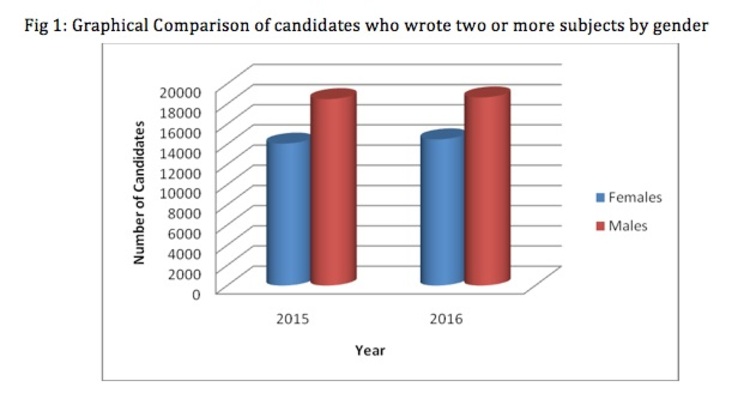STEM subjects remain popular at A-Level

 Christopher Farai Charamba Review Writer —
Christopher Farai Charamba Review Writer —
It was Malcolm X who said, “Education is the passport to the future, for tomorrow belongs to those who prepare for it today.”
The day of reckoning, to gauge how successful those preparations have been for 2016 Advanced Level students, came a few days ago when the Zimsec A-Level examination results were released.
Speaking at an event to mark the release of the results last Friday, Primary and Secondary Education Minister Dr Lazarus Dokora said the candidates should be praised for meeting their expectations.
“The Advanced Level candidates are worth celebrating, cognisant of the fact that they are the few candidates creamed off after the Ordinary Level examinations, and the general expectation is that the results are high,” he said.
Chairman of the Zimsec Board Professor Levy Nyagura concurred with the Minister that the results for the 2016 November examinations were commendable.
“Grading standards for each A-Level subject did not change. The standards have been benchmarked to previous ones and maintained in all subjects. Generally, the performance of November 2016 candidates was commendable in most subjects and reasons for this performance vary from subject to subject,” he said.
An analysis of the results shows that of the 41 549 candidates who sat for A-Level exams in November 2016, 38 924 obtained a Grade E or better in one or more subjects, translating to a pass rate of 93,7 percent.
This pass rate was 0,4 percent higher than the pass rate of 2015, despite also the fact that there was a slight decrease of 104 candidates between the two years.
The decrease in the number of candidates was among private candidates who in 2015 were 8 889 and in 2016 they were 8 149. In terms of school candidates, the analysis shows that the numbers increased between 2015 and 2016 from 32 764 to 33 400.
What is particularly striking to note in the analysis of the results is the growing proclivity for Science, Technology, Engineering and Mathematics (STEM) subjects by A-level learners, this too before the STEM initiative launched by the Ministry of Higher and Tertiary Education, Science and Technology Development.
One of the more serious objectives undertaken during the education curriculum change was the advancement of STEM subjects and the trend in recent years shows that this is starting to pay off with the number of candidates increasing in the STEM subjects.
There were varied increments in the number of candidates who sat for Mathematics, Chemistry, Computing, with Physics seeing the largest increase of 530 more candidates in 2016 than in 2015.
Mathematics and Biology were the two STEM subjects which saw a slight decrease in the number of candidates who sat for them. Their numbers were however, higher than those who sat in 2014.
While there were more candidates sitting for STEM subjects at A-Level, there were however, slight reductions in the pass rate in some of the subjects. Further, Mathematics saw a 2,68 percentage decrease in the pass rate from 96,12 percent to 93,44 percent for school candidates.
In Physics the pass rate reduced from 83,8 percent to 78,92 percent, a reduction of 4,88 percent for school candidates. Computing, which increased from 500 to 814 candidates, also had a slight decrease of 1,69 percent from 98 percent to 96,31 percent
Mathematics, with a pass rate of 79,07; Chemistry with a pass rate of 82,66 and Biology with a pass rate of 88,08 saw increases in the pass rate of 6,89 percent, 2,44 percent and 7,74 percent respectively.
Education Coalition national coordinator Mr Maxwell Rafamoyo said the growing preference for STEM subjects was a result of students, parents and educators realising that the world is changing and that economies are now geared for those in the STEM field.
“The growing number of students taking up STEM subjects is because they realise that the world we live in today requires those skills. Students are leaving arts and commercial subjects because these do not translate into the demand of the technological modern times,” he said.
According to Mr Rafamoyo, the increase in STEM students has been the trend for the past few years and aside from a realisation in the demand for STEM individuals, the Government has also contributed to this trend.
“Before the Ministry of Higher and Tertiary Education’s STEM initiative, the Ministry of Primary and Secondary Education had already embarked on policies that promoted the growth of STEM subjects in high schools.
“For example, they have a policy which states that all schools that wish to offer A-Level subjects must have a science block. This has been the case for a few years now and different from before in that with the availability of a science block, it in turn encourages students to take up STEM subjects,” he added.
Commerce subjects were the ones which saw the most reductions in candidates sitting in 2016. Business studies, Accounting and Economics all saw reductions of 4,65 percent, 11,84 percent and 2,87 percent respectively.
Other notable analysis was the performance of students by gender between 2015 and 2016. There was an increase of both male and female candidates who wrote two more subjects from 18 479 to 18 650 and 14 071 to 14 489 respectively.
The pass rates for both male and female candidates also increased from the previous year by 1 percent for males from 85,4 percent to 86,4 percent and by 1,1 percent for females from 90,5 percent to 91,6 percent.
According to Prof Nyagura there were more male candidates 662, who obtained 15 points or more than female candidates, 280.
“Of the candidates who obtained 15 points and above the highest were three male candidates with 29 points. At the top of the female candidate list are eight with 20 points each,” he said.
All three of the male candidates had combinations of majority science subjects while four of the eight female candidates also sat in science subjects, the rest divided between arts and commerce.
On why female students had overall, outperformed their male counterparts overall, Mr Rafamoyo said he was reticent on the issue as it would need further analysis to gauge what the trend has been over the years rather than pass a general comment.
One noticeable aspect in the Zimsec November 2016 examinations were the number of special needs candidates who sat for examinations and their performance.
Forty-one special needs candidates sat in 2016, 14 were Braille and 27 for enlarged print.
Dr Dokora said he was happy that candidates with special needs had also been examined by Zimsec.
“As a ministry, we are also proud that Zimsec has provided for special needs candidates who wrote the Advanced Level examinations. The categories of these include Braille candidates and enlarged print candidates.
“Candidates in these two categories performed well in Divinity which seems to have been the most popular subject. The assessment of special needs candidates is also provided for in the new curriculum’s inclusive approach in terms of the teaching and learning approaches,” he said.
Mashonaland East had the top performing candidates for female students with a pass rate of 95,9 percent while Mashonaland Central had the top performing male candidates with a pass rate of 91,2 percent.
The least performing provinces female students were Matabeleland North, Matabeleland South, Mashonaland West with pass rates of 89.3 percent. For male candidates, the least performing province was Harare with a 79,0 percent pass rate.










Comments